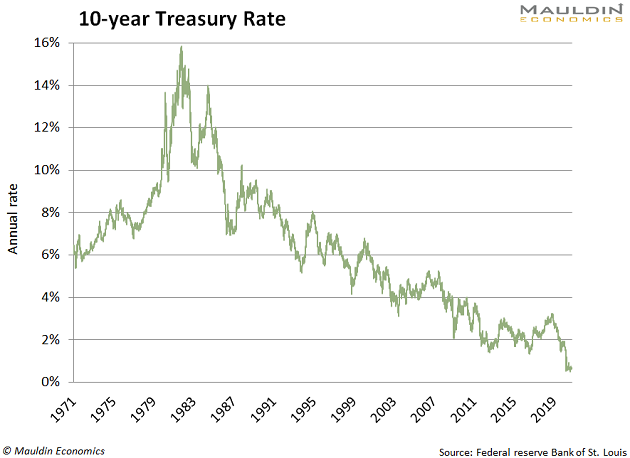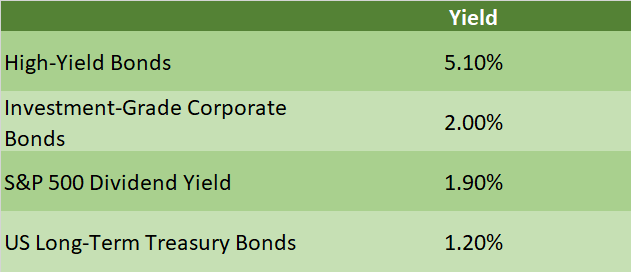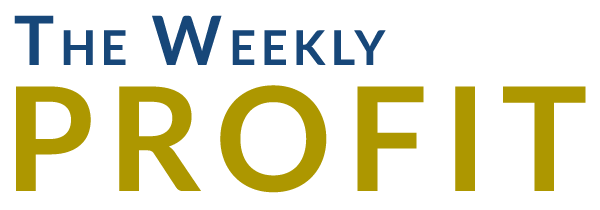
How to Pick the Right Dividend-Paying Stocks
- Robert Ross
- |
- The Weekly Profit
- |
- October 7, 2020
Earning steady income from your investments has never been harder.
Today’s certificates of deposit (CDs) yielding next to nothing…

Same for US government bonds…

Income investors desperately need dividend-paying stocks.
But there’s a problem: Most dividend-paying stocks barely generate any income!
The S&P 500 dividend yield is currently a measly 1.9%:

That’s just below the yield on investment-grade bonds. While that yield will help you beat inflation, it won’t do much in terms of real income. To generate steady income and beat inflation, you need a yield of at least 4%.
So not only do you need dividend-paying stocks in your portfolio, you need dividend-paying stocks that pay at least double the average yield.
That’s easier said than done. Because the higher the dividend yield, the more likely it is that dividend is NOT safe. And considering that 2020 is the worst year for dividend-paying stocks since the Global Financial Crisis, you have to be careful where you park your cash.
Let me show you a few ways to tell if a dividend yield is safe or not.
The Best Way to Tell If a Dividend Yield Is Safe
Whenever I consider a dividend-paying stock, the first thing I do is run the company through my Dividend Sustainability Index (DSI). This is a tool I developed to gauge the safety of a company’s dividend.
There are three key factors in my model: payout ratio, debt-to-equity ratio, and free cash flow.
The payout ratio is the percentage of net income a firm pays to its shareholders as dividends. If a company pays a dividend of $1.00 and generates annual earnings-per-share of $2.00, that means the company has a payout ratio of 50%.
As a rule of thumb, any payout ratio below 80% is safe.
Next we have the debt-to-equity ratio. The more debt a company has, the harder it gets to run a business. This includes—you guessed it—paying the dividend.
Last but not least, we have free cash flow. This is the amount of cash left over after a company pays its expenses and funds the dividend.
If any of these measures is flashing red, you know the dividend is in trouble.
These +4% Dividend Payers Pass the Dividend Sustainability Index
Dividend payers that yield over 4% can often be traps. But you should feel safe with any DSI-approved pick.
One of my favorites is Pfizer Inc. (PFE), one of the world’s leading pharmaceutical companies. In addition to working on a COVID-19 vaccine, the company is a leader in cardiovascular, neuroscience, and other life-saving therapies.
Pfizer is a great option for dividend investors. With a 4.2% dividend yield and a low payout ratio, low debt, and strong free cash flow, the company scored a perfect 100 on the DSI.
Next on my list is KeyCorp. (KEY). The Ohio-based regional bank serves middle-market clients in 16 states throughout the US.
KeyCorp sports a hefty 6.1% dividend yield. While I’d normally be wary of such a high yield, KeyCorp scored a 96 out of a possible 100 on the Dividend Sustainability Index.
Another favorite is Omnicom Group Inc. (OMC), the world’s second-largest ad holding company. 85% of OMC’s revenue comes from developed markets in North America and Europe.
And it pays a whopping 5.1% dividend yield. The company has a low payout ratio, steady free cash flow, and a manageable debt load. That grants the company an excellent DSI score of 90 out of 100.
In my premium investing service Yield Shark, I constantly monitor the portfolio’s dividend sustainability. That’s why I’ve never had a company cut its dividend.
If you are looking for income, you should read about my latest top recommendation: a company with a safe, 11% dividend yield. And—like all my recommendations in Yield Shark—it has a solid DSI score of 92 out of 100.
Give my Yield Shark research service a try for 30 days and join thousands of happy income investors. Click here for all the details.

Robert Ross

